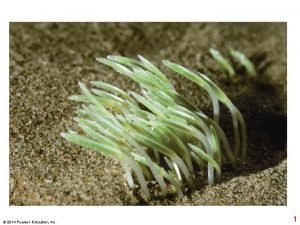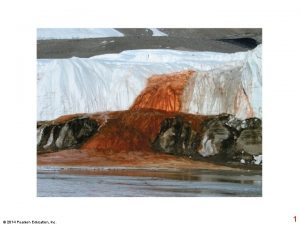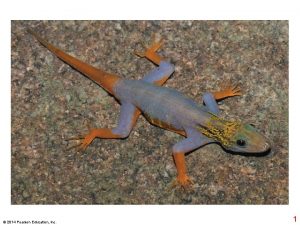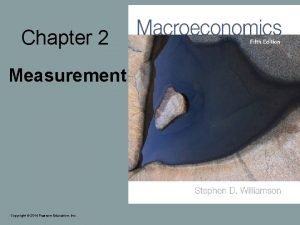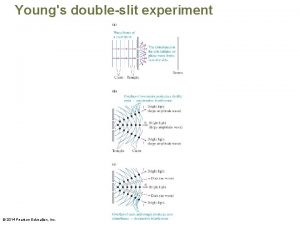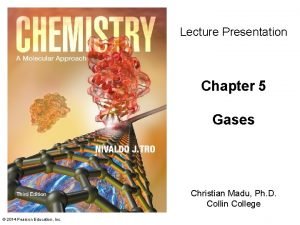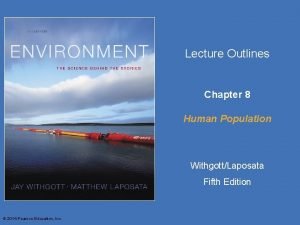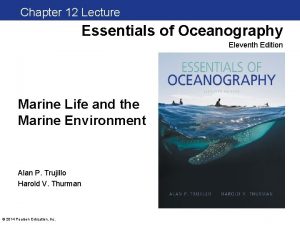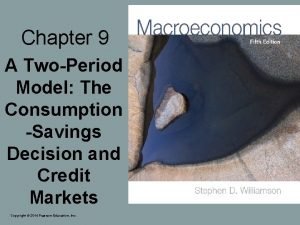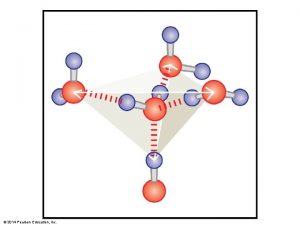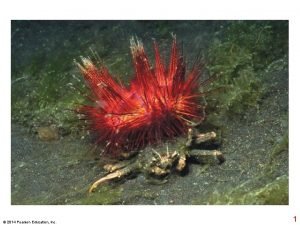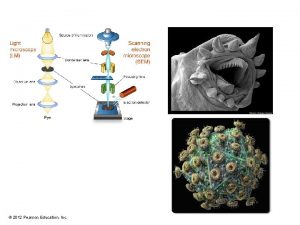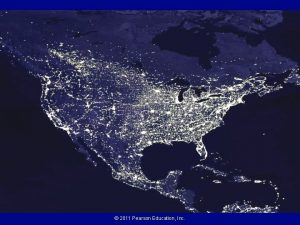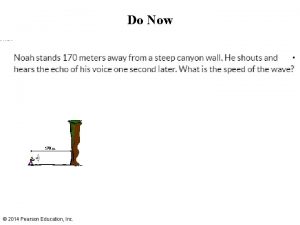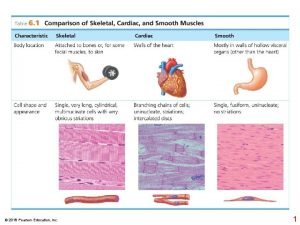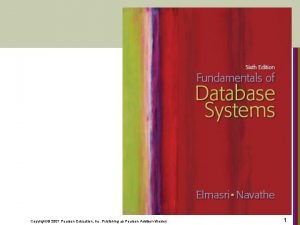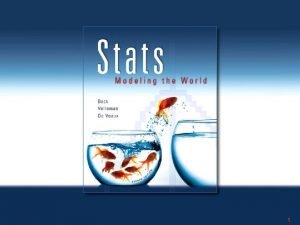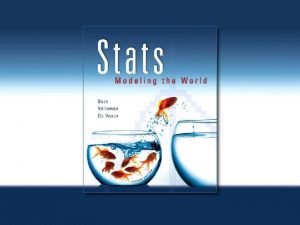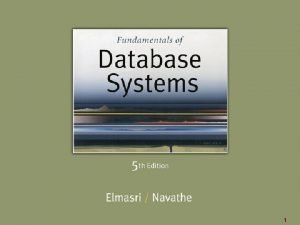2014 Pearson Education Inc 1 2014 Pearson Education



























- Slides: 27

© 2014 Pearson Education, Inc. 1

© 2014 Pearson Education, Inc. 2

Genetic diversity: source of variations that enable populations to adapt to environmental changes Species diversity: important in maintaining structure of communities and food webs Ecosystem diversity: provides life-sustaining services such as nutrient cycling and waste decomposition © 2014 Pearson Education, Inc. 3

Philippine eagle Yangtze River dolphin © 2014 Pearson Education, Inc. 4

© 2014 Pearson Education, Inc. 5

© 2014 Pearson Education, Inc. 6

© 2014 Pearson Education, Inc. 7

© 2014 Pearson Education, Inc. 8

© 2014 Pearson Education, Inc. 9

4. 8 4. 7 4. 6 p. H 4. 5 4. 4 4. 3 4. 2 4. 1 4. 0 1960 ’ 65 © 2014 Pearson Education, Inc. ’ 70 ’ 75 ’ 80 ’ 85 ’ 90 Year ’ 95 2000 ’ 05 ’ 10 10

Small population Inbreeding, genetic drift Lower reproduction, higher mortality Loss of genetic variability Lower individual fitness and population adaptability Smaller population © 2014 Pearson Education, Inc. 11

Number of male birds Results 200 150 100 Translocation 50 Eggs hatched (%) 0 1975 1980 1985 1990 1995 Year (a) Population dynamics 100 90 80 70 60 50 40 30 1970–’ 74 ’ 75–’ 79 ’ 80–’ 84 ’ 85–’ 89 (b) Hatching rate © 2014 Pearson Education, Inc. Years ’ 90 ’ 93–’ 97 12

© 2014 Pearson Education, Inc. 13

© 2014 Pearson Education, Inc. 14

© 2014 Pearson Education, Inc. 15

© 2014 Pearson Education, Inc. 16

Equator Earth’s terrestrial ( ) and marine ( ) biodiversity hot spots © 2014 Pearson Education, Inc. 17

0 50 100 Kilometers MONTANA Yellowstone National Park MONTANA IDAHO Sn ak . IDAHO WYOMING e. R Grand Teton National Park © 2014 Pearson Education, Inc. WYOMING Biotic boundary for short-term survival; MVP is 50 individuals. Biotic boundary for long-term survival; MVP is 500 individuals. 18

Nicaragua CARIBBEAN SEA Costa Rica National park land Buffer zone PACIFIC OCEAN © 2014 Pearson Education, Inc. 19

© 2014 Pearson Education, Inc. 20

Concentration of PCBs Herring gull eggs 124 ppm Lake trout 4. 83 ppm Smelt 1. 04 ppm Zooplankton 0. 123 ppm © 2014 Pearson Education, Inc. Phytoplankton 0. 025 ppm 21

Pharmaceuticals Toilet Humans Farm animals Sludge Manure Farms Agricultural runoff Treated effluent Sewage treatment plant © 2014 Pearson Education, Inc. Lakes and rivers 22

14. 9 390 14. 8 14. 7 14. 6 370 Temperature 14. 5 360 14. 4 350 14. 3 14. 2 340 CO 2 330 14. 1 14. 0 13. 9 320 13. 8 310 300 Average global temperature ( C) CO 2 concentration (ppm) 380 13. 7 13. 6 1960 1965 1970 1975 1980 1985 1990 1995 2000 2005 2010 Year © 2014 Pearson Education, Inc. 23

(a) Current range © 2014 Pearson Education, Inc. (b) 4. 5 C warming over next century (c) 6. 5 C warming over next century 24

6 5 4 3 2 1 Human population (billions) 7 0 8000 4000 3000 2000 1000 BCE BCE BCE © 2014 Pearson Education, Inc. 0 1000 2000 CE CE 25

2. 2 2. 0 Annual percent increase 1. 8 1. 6 1. 4 2011 1. 2 Projected data 1. 0 0. 8 0. 6 0. 4 0. 2 0 © 2014 Pearson Education, Inc. 1950 1975 2000 Year 2025 2050 26

Energy use (GJ): © 2014 Pearson Education, Inc. 300 150– 300 50– 150 10– 50 10 27
 2014 pearson education inc
2014 pearson education inc 2014 pearson education inc
2014 pearson education inc 2014 pearson education inc
2014 pearson education inc 2014 pearson education inc
2014 pearson education inc 2014 pearson education inc
2014 pearson education inc 2014 pearson education inc
2014 pearson education inc 2014 pearson education inc
2014 pearson education inc 2014 pearson education inc
2014 pearson education inc 2014 pearson education inc
2014 pearson education inc 2014 pearson education inc
2014 pearson education inc 2014 pearson education inc
2014 pearson education inc 2014 pearson education inc
2014 pearson education inc 2014 pearson education inc
2014 pearson education inc 2014 pearson education inc
2014 pearson education inc 2014 pearson education inc
2014 pearson education inc 2014 pearson education inc
2014 pearson education inc 2014 pearson education inc
2014 pearson education inc 2014 pearson education inc
2014 pearson education inc 2014 pearson education inc
2014 pearson education inc Marine species
Marine species 2014 pearson education inc
2014 pearson education inc 2014 pearson education inc
2014 pearson education inc 2014 pearson education inc
2014 pearson education inc 2014 pearson education inc
2014 pearson education inc 2014 pearson education inc
2014 pearson education inc 2014 pearson education inc
2014 pearson education inc 2014 pearson education inc
2014 pearson education inc 2014 pearson education inc
2014 pearson education inc





